Soil Moisture Behavior in Relation to Topography and Land Use for Two Andean Colombian Catchments
Abstract
1. Introduction
2. Materials and Methods
2.1. Study Site
2.2. Soil Survey and Pedostratigraphic Description and Analisys
2.3. Field Instrumentation
2.4. Data Analysis
3. Results and Discussion
3.1. Rainfall Behavior
3.2. Soil Moisture Behavior
3.3. Topographic Wetness Index—TWI
3.4. Soil Moisture Variability for Different Soils Uses
3.5. Water Behavior at Microcatchment Scale
4. Conclusions
Author Contributions
Funding
Institutional Review Board Statement
Informed Consent Statement
Data Availability Statement
Acknowledgments
Conflicts of Interest
References
- Roa-García, M.C.; Brown, S.; Schreier, H.; Lavkulich, L.M. The role of land use and soils in regulating water flow in small headwater catchments of the Andes. Water Resour. Res. 2011, 47. [Google Scholar] [CrossRef]
- Rampazzo, N.; Blum, W.E.H.; Wimmer, B. Assessment of soil structure parameters and functions in agricultural soils. Bodenkultur 1998, 49, 69–84. [Google Scholar]
- Pardo, A.; Amato, M.; Chiarandà, F.Q. Relationships between soil structure, root distribution and water uptake of chickpea (Cicer arietinum L.). Plant growth and water distribution. Eur. J. Agron. 2000, 13, 39–45. [Google Scholar] [CrossRef]
- Franzluebbers, A. Water infiltration and soil structure related to organic matter and its stratification with depth. Soil Tillage Res. 2002, 66, 197–205. [Google Scholar] [CrossRef]
- Lai, X.; Liao, K.; Feng, H.; Zhu, Q. Responses of soil water percolation to dynamic interactions among rainfall, antecedent moisture and season in a forest site. J. Hydrol. 2016, 540, 565–573. [Google Scholar] [CrossRef]
- Zimmermann, B.; Elsenbeer, H.; De Moraes, J.M. The influence of land-use changes on soil hydraulic properties: Implications for runoff generation. For. Ecol. Manag. 2006, 222, 29–38. [Google Scholar] [CrossRef]
- Bruijnzeel, L. Hydrological functions of tropical forests: Not seeing the soil for the trees? Agric. Ecosyst. Environ. 2004, 104, 185–228. [Google Scholar] [CrossRef]
- Ramírez, B.H.; Teuling, A.J.; Ganzeveld, L.; Hegger, Z.; Leemans, R. Tropical Montane Cloud Forests: Hydrometeorological variability in three neighbouring catchments with different forest cover. J. Hydrol. 2017, 552, 151–167. [Google Scholar] [CrossRef]
- Guo, X.; Fu, Q.; Hang, Y.; Lu, H.; Gao, F.; Si, J. Spatial Variability of Soil Moisture in Relation to Land Use Types and Topographic Features on Hillslopes in the Black Soil (Mollisols) Area of Northeast China. Sustainability 2020, 12, 3552. [Google Scholar] [CrossRef]
- WMO. Guide to Meteorological Instruments and Methods of Observation, 7th ed.; WMO-No. 8; WMO: Geneva, Switzerland, 2008; Cap. I.4-1–I.4-30; Available online: https://mail.google.com/mail/u/0/?ogbl#inbox?compose=new&projector=1 (accessed on 19 May 2021).
- Florentino, A. Métodos para medir el contenido de agua en el suelo. Venesuelos 2006, 14, 48–70. [Google Scholar]
- Loaiza-Usuga, J.C.; Pauwels, V.R.N. Utilización de sensores de humedad para la determinación del contenido de agua en el suelo (Ecuaciones de Calibración). Suelos Ecuat. SCCS 2008, 38, 24–33. [Google Scholar]
- Moran, M.S.; McElroy, S.; Watts, J.M.; Peters-Lidard, C.D. Radar Remote Sensing for Estimation of Surface Soil Moisture at the Watershed Scale. Can. J. Remote Sens. 2004, 30. [Google Scholar] [CrossRef]
- Loew, A.; Stacke, T.; Dorigo, W.; de Jeu, R.; Hagemann, S. Potential and limitations of multidecadal satellite soil moisture observations for selected climate model evaluation studies. Hydrol. Earth Syst. Sci. 2013, 17, 3523–3542. [Google Scholar] [CrossRef]
- Yang, T.; Ala, M.; Zhang, Y.; Wu, J.; Wang, A.; Guan, D. Characteristics of soil moisture under different vegetation coverage in Horqin Sandy Land, northern China. PLoS ONE 2018, 13, e0198805. [Google Scholar] [CrossRef]
- Llorens, P.; Latron, J.; Gallart, F. Dinámica espacio-temporal de la humedad del suelo en un área de montaña mediterránea. Cuencas experimentales de Vallcebre (Alto Llobregat). Estud. Zona No Saturada Suelo 2003, 6, 71–76. [Google Scholar]
- Dörner, J.; Huertas, J.; Cuevas, J.G.; Leiva, C.; Paulino, L.; Arumí, J.L. Water content dynamics in a volcanic ash soil slope in southern Chile. J. Plant Nutr. Soil Sci. 2015, 178, 693–702. [Google Scholar] [CrossRef]
- Berbesí-Jaimes, A.; Loaiza-Usuga, J.C.; Casamitjana-Causa, M.; Cardona-Gallo, S.; Correa, G.A. Hydrogeochemical nitrogenous behaviour in an Andean agricultural basin. In Water in Agricultural Practices: Training the Trainers: Water Perspectives in Emerging Countries; Cuvillier Verlag: Göttingen, Germany, 2019; ISBN 9783736971004. [Google Scholar]
- Buytaert, W.; Deckers, J.; Dercon, G.; De Bièvre, B.; Poesen, J.; Govers, G. Impact of land use changes on the hydrological properties of volcanic ash soils in South Ecuador. Soil Use Manag. 2006, 18, 94–100. [Google Scholar] [CrossRef]
- Nanzyo, M.; Shoji, S.; Dahlgren, R. Physical characteristics of volcanic ash soils. In Volcanic Ash Soils: Genesis, Properties and Utilization, Development in Soil Science; Shoji, S., Nanzio, M., Dahlgren, R., Eds.; Elsevier: Amsterdam, The Netherlands, 1993; Volume 17, pp. 189–201. [Google Scholar]
- Poulenard, J.; Podwojewski, P.; Janeau, J.-L.; Collinet, J. Runoff and soil erosion under rainfall simulation of Andisols from the Ecuadorian Páramo: Effect of tillage and burning. Catena 2001, 45, 185–207. [Google Scholar] [CrossRef]
- Ivelic-Sáez, J.; Zúñiga, F.; Valle, S.; Lopez, I.; Dec, D.; Dörner, J. Functional resistance and resilience of the pore system of an andisol exposed to different strategies of pasture improvement under sheep grazing. J. Soil Sci. Plant Nutr. 2015, 15, 663–679. [Google Scholar] [CrossRef]
- SSS. Soil Survey Field and Laboratory Methods Manual; Burt and Soil Survey Staff, Ed.; Soil Survey Investigations Report No. 51, Version 2.0; USDA U.S. Department of Agriculture, Natural Resources Conservation Service: Washington, DC, USA, 2014.
- IGAC. Estudio General de Suelos y Zonificación de Tierras del Departamento del Tolima; Instituto Geografico Agustin Codazzi: Bogota, Colombia, 1997.
- IGAC. Estudio General de Suelos y Zonificación de Tierras del Departamento del Valle del Cauca; Instituto Geografico Agustin Codazzi: Bogota, Colombia, 2005.
- Holdridge, L.R. Life Zone Ecology; Tropical Science Center: San José, Costa Rica, 1967. [Google Scholar]
- Haan, C.T.; Barfield, B.J.; Hayes, J.C. Design Hydrology and Sedimentology for Small Catchments; Academic Press: Cambridge, MA, USA, 1994; 588p. [Google Scholar]
- Haigh, M.J.; Jansky, L.; Hellin, J. Headwater deforestation: A challenge for environmental management. Glob. Environ. Chang. 2004, 14, 51–61. [Google Scholar] [CrossRef]
- SSS. Soil Survey Manual. In USDA Handbook 18; Ditzler, C., Scheffe, K., Monger, H.C., Eds.; Government Printing Office: Washington, DC, USA, 2017. [Google Scholar]
- Bouyoucos, G.J. Hydrometer method improved for making particle size analysis of soils. Agron. J. 1962, 54, 464–465. [Google Scholar] [CrossRef]
- Paltineanu, I.C.; Starr, J.L. Real-time Soil Water Dynamics Using Multisensor Capacitance Probes: Laboratory Calibration. Soil Sci. Soc. Am. J. 1997, 61, 1576–1585. [Google Scholar] [CrossRef]
- Sidle, R.C.; Gomi, T.; Usuga, J.C.L.; Jarihani, B. Hydrogeomorphic processes and scaling issues in the continuum from soil pedons to catchments. Earth-Sci. Rev. 2017, 175, 75–96. [Google Scholar] [CrossRef]
- Jaramillo, Á.; Chaves, B. Distribución de la precipitación en Colombia analizada mediante conglomeración estadística. Cenicafé 2000, 51, 102–113. [Google Scholar]
- Hoyos, N.; Waylen, P.R.; Jaramillo, A. Seasonal and spatial patterns of erosivity in a tropical watershed of the Colombian Andes. J. Hydrol. 2005, 314, 177–191. [Google Scholar] [CrossRef]
- Vásquez-Velásquez, G. Headwaters Deforestation for Cattle Pastures in the Andes of Colombia and Its Implications for Soils Properties and Hydrological Dynamic. Open J. For. 2016, 6, 337–347. [Google Scholar] [CrossRef]
- Muñoz-Villers, L.; Holwerda, F.; Gómez-Cárdenas, M.; Equihua, M.; Asbjornsen, H.; Bruijnzeel, L.; Marín-Castro, B.; Tobón, C. Water balances of old-growth and regenerating montane cloud forests in central Veracruz, Mexico. J. Hydrol. 2012, 462–463, 53–66. [Google Scholar] [CrossRef]
- Zhan, T.; Qiu, Q.; Xu, W. Analytical solution for infiltration and deep percolation of rainwater into a monolithic cover subjected to different patterns of rainfall. Comput. Geotech. 2016, 77, 1–10. [Google Scholar] [CrossRef]
- Venkatesh, B.; Lakshman, N.; Purandara, B.; Reddy, V. Analysis of observed soil moisture patterns under different land covers in Western Ghats, India. J. Hydrol. 2011, 397, 281–294. [Google Scholar] [CrossRef]
- Rodriguez-Vagaria, A.; Gaspari, F. GeoQ: Herramienta para la determinación del número de curva y escorrentía bajo entorno SIG IDRISI ANDES. Rev. Int. Cienc. Tecnol. Inf. Geogr. 2010, 10, 11–26. [Google Scholar] [CrossRef]
- Leiva, N.; Rubiano, Y.; Peña, A.J. Evaluation of soil moisture using topographic (dem), climate and soil parameters in a piedmont area of Villavicencio. Rev. EIA 2015, 12, 61–75. [Google Scholar]
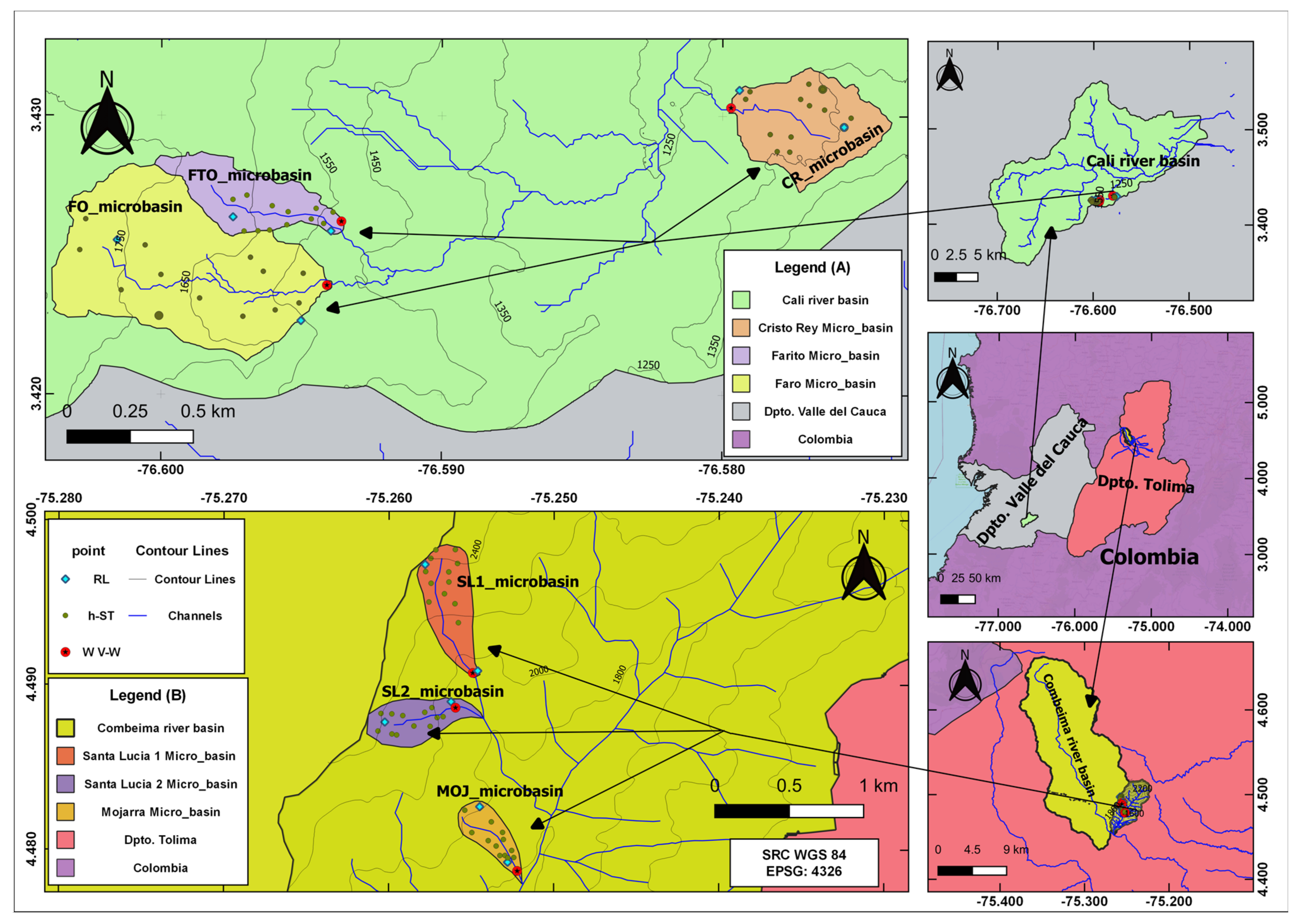
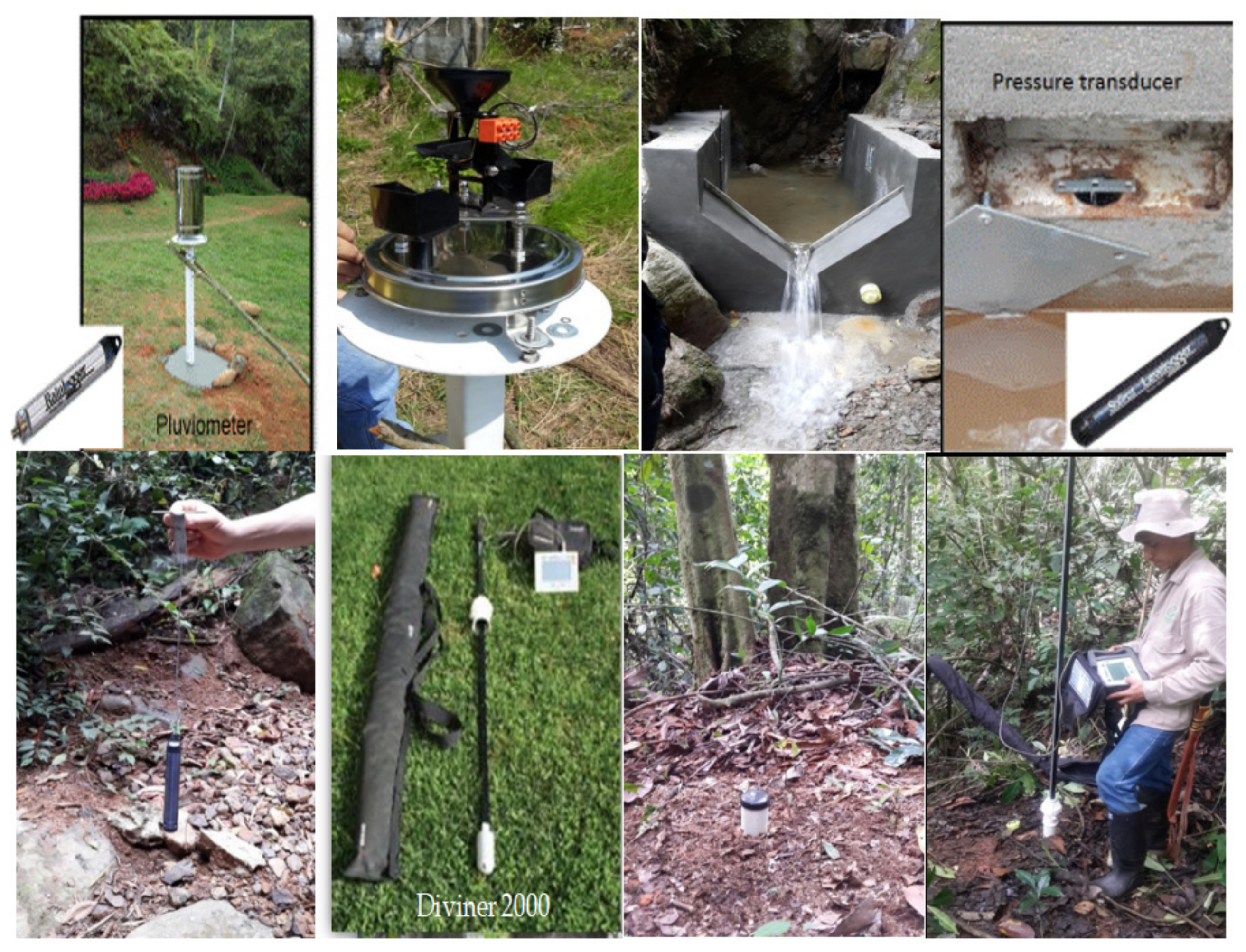
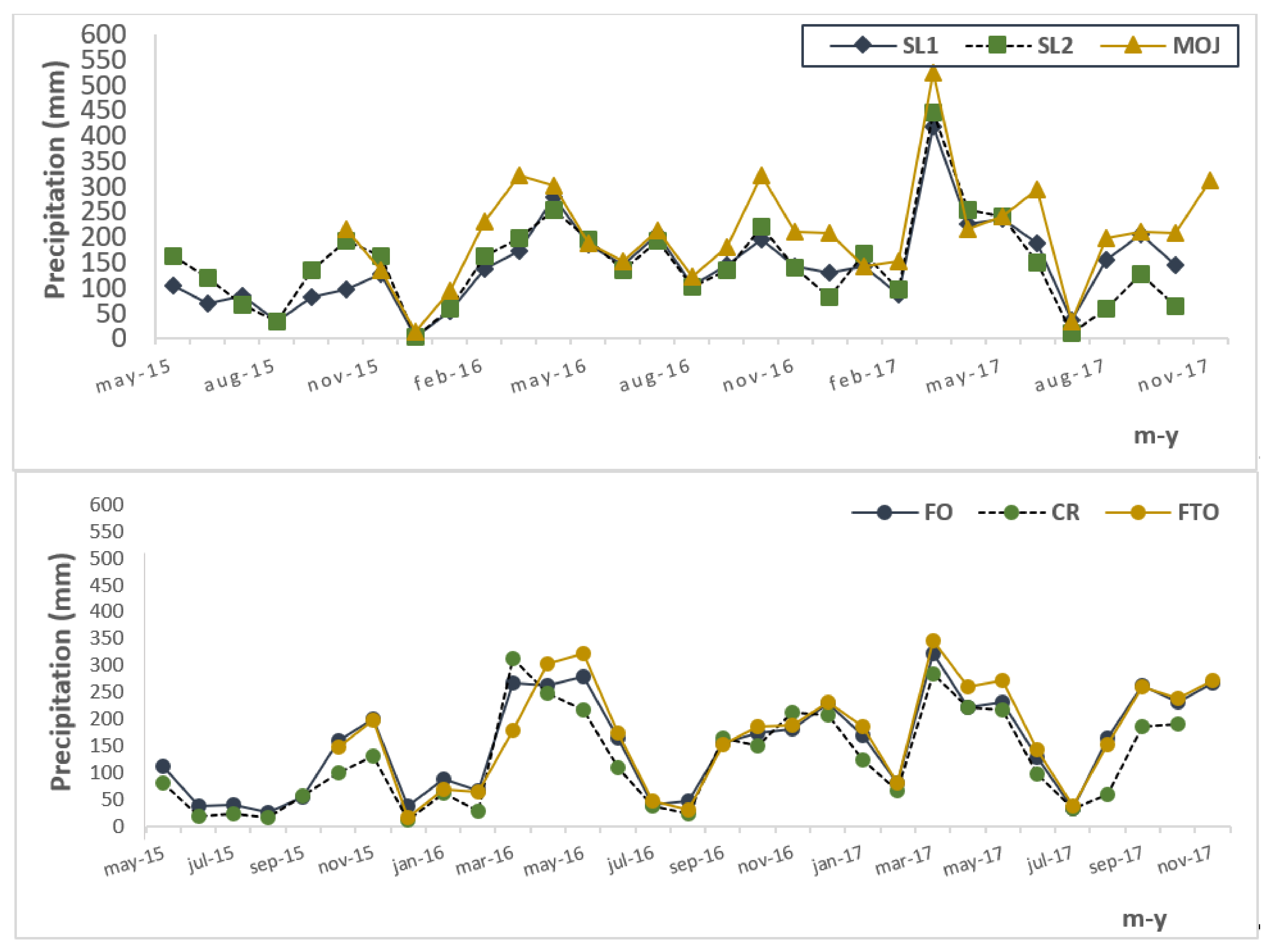
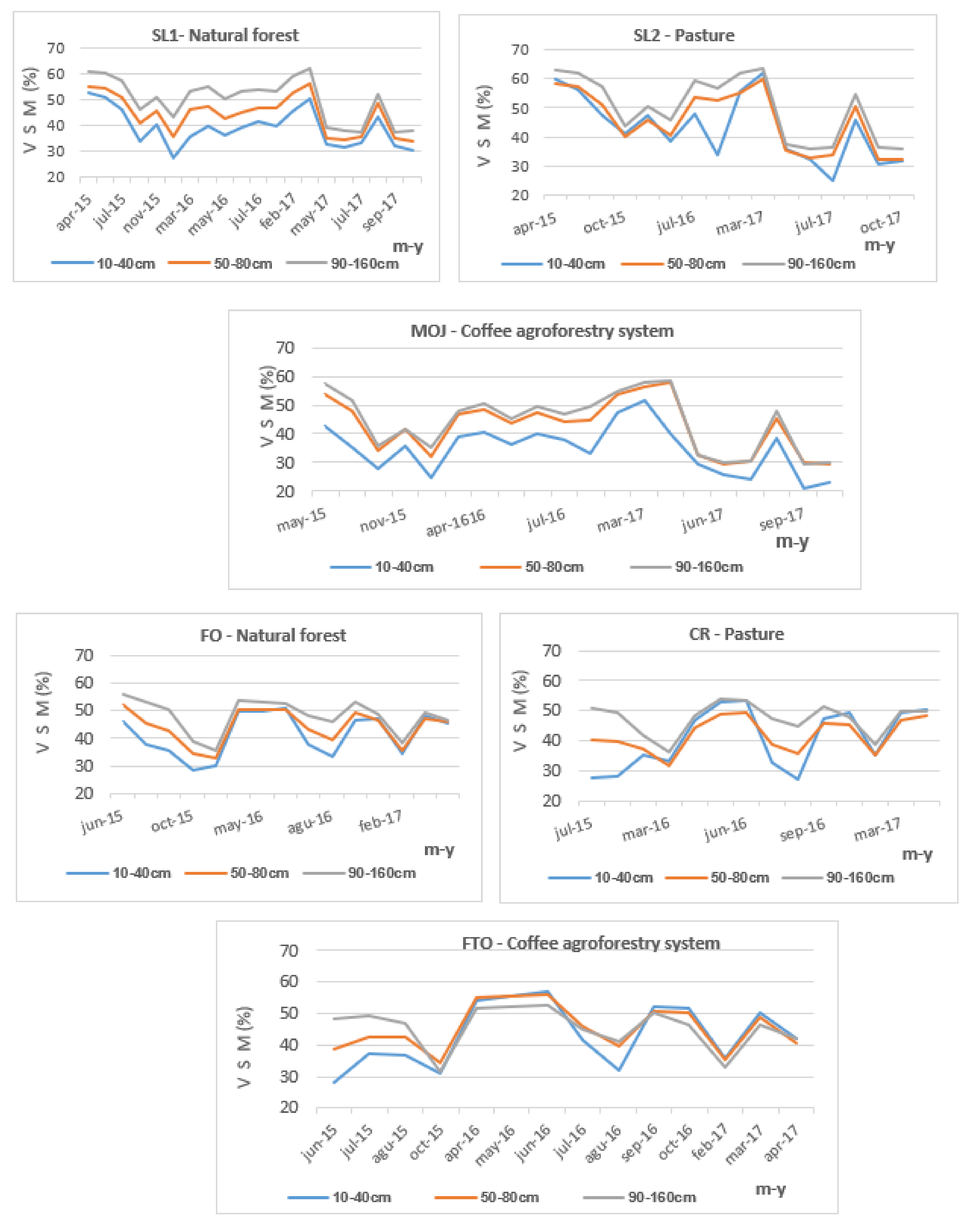
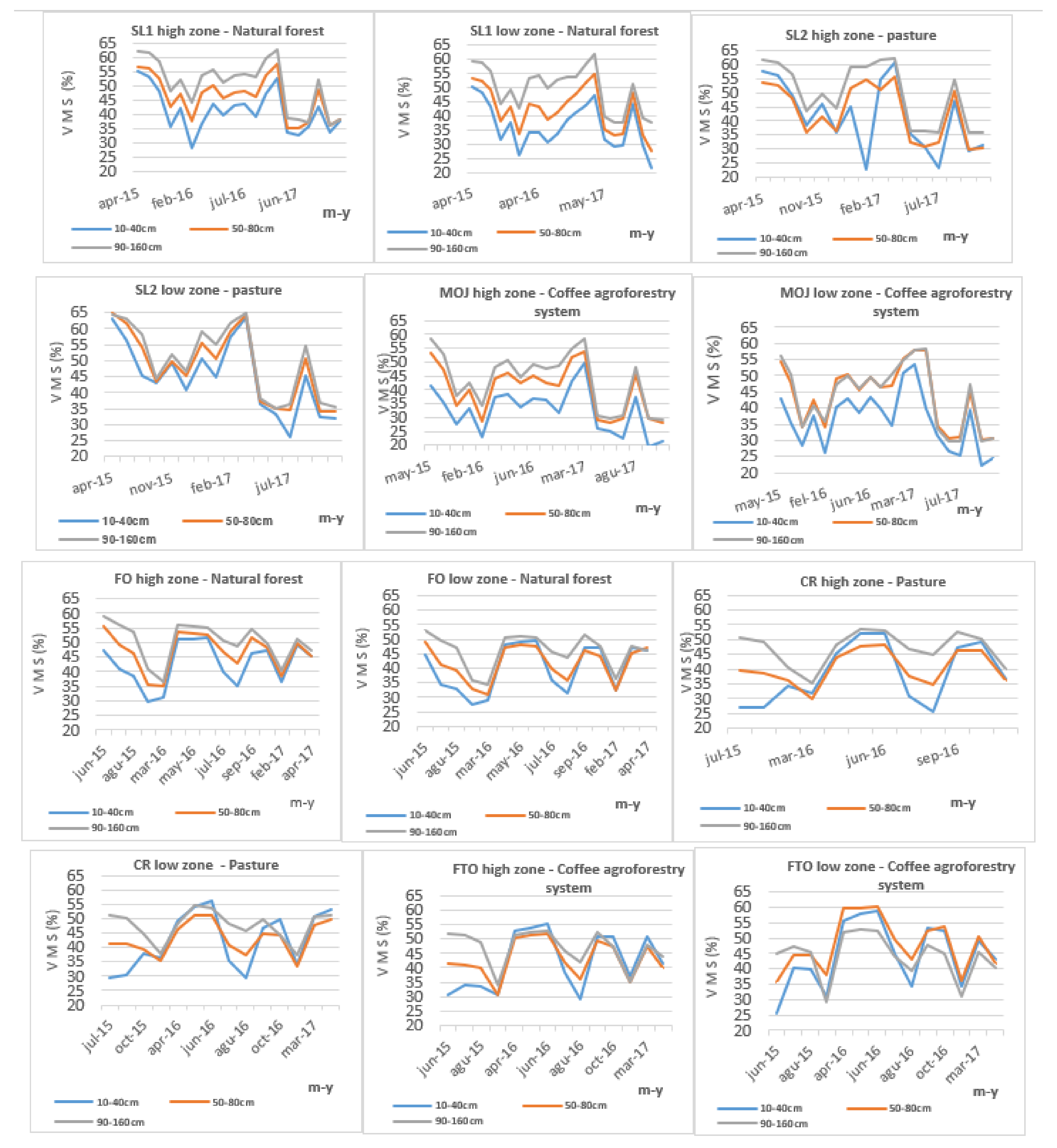
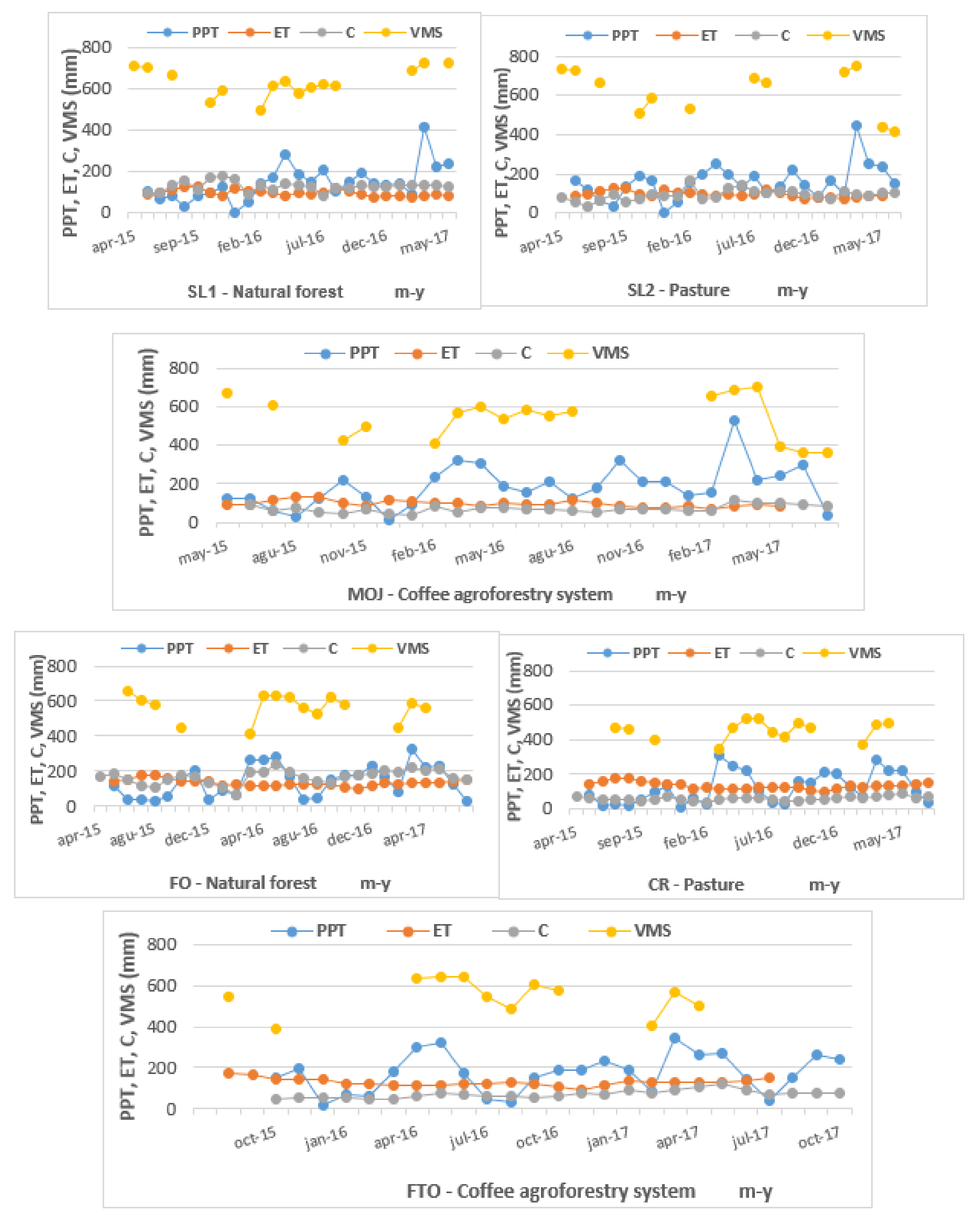
| Microbasins | Area (ha) | Coordenades | Altitude Gradient (m.a.s.l) | |
|---|---|---|---|---|
| North | West | |||
| Combeima River Basin | ||||
| Natural forest (SL1) | 22.8 | 4°29.178′ N | 075°15.284′ W | 1932–2322 |
| 4°29.443′ N | 075°15.306′ W | |||
| Pasture (SL2) | 16.3 | 4°29.294′ N | 075°15.657′ W | 1928–2244 |
| 4°29.323′ N | 075°15.396′ W | |||
| Coffee agroforestry system (MOJ) | 10.8 | 4°28.972′ N | 075°15.270′ W | 1590–1830 |
| 4°28.159′ N | 075°15.149′ W | |||
| Cali River Basin | ||||
| Natural forest (FO) | 51.5 | 3°25.468′ N | 076°36.086′ W | 1484–1764 |
| 3°25.425′ N | 076°35.646′ W | |||
| Pasture (CR) | 16.5 | 3°25.777′ N | 076°34.540′ W | 1266–1386 |
| 3°25.818′ N | 076°34.782′ W | |||
| Coffee agroforestry system (FTO) | 10.5 | 3°25.591′ N | 076°35.837′ W | 1524–1692 |
| 3°25.573′ N | 076°35.615′ W | |||
| Microbasin/Basin | Area (ha) | Pp (mm) | T (°C) | RH (%) | GP | MP | Classification (SSS, 2014) | Soil Uses | Life Zones |
|---|---|---|---|---|---|---|---|---|---|
| Combeima River Basin | |||||||||
| SL1 | 22.8 | 15781 ± 37.6 | 20.8 | 79.5 | Steep hillslope | Granodiorite | Typic Eutrodepts | Natural forest | Premontane humid forest (P-hf) |
| SL2 | 16.3 | 1730.6 ± 20.9 | 20.8 | 79.5 | Pasture | ||||
| MOJ | 10.8 | 2353.5 ± 23.0 | 20.8 | 79.5 | Coffee agroforestry system | ||||
| Cali River Basin | |||||||||
| FO | 51.5 | 1594.6 ± 71.1 | 25.4 | 70.6 | Moderately steep hillslope | Basaltic | Typic Haplustalfs | Natural forest | Premontane dry forest (P-df) |
| CR | 16.5 | 1340 ± 55.4 | 25.4 | 70.6 | Pasture | ||||
| FTO | 10.5 | 1892.4 ± 62.5 | 25.4 | 70.6 | Coffee agroforestry system | ||||
| Microbasin/Basin | Texture | Bulk Density (gr/cm3) | Volumetric Soil Moisture (%) | MRC (%) |
|---|---|---|---|---|
| Combeima River Basin | ||||
| Natural forest (SL1) | Sandy loam | 1.09 | 22–62.5 | 56–61.5 |
| Pasture (SL2) | 1.14 | 27.5–64.5 | 56–59.5 | |
| Coffee agroforestry system (MOJ) | Sandy clay loam | 1.34 | 18.5–59.2 | 50–56.2 |
| Cali River Basin | ||||
| Natural forest (FO) | Clay loam | 1.06 | 26.5–58.5 | 43–48 |
| Pasture (CR) | Clay | 1.13 | 25–55 | 41.5–46 |
| Coffee agroforestry system (FTO) | 0.97 | 21–54.5 | 36.2–41.6 | |
| Item/Minutes | SL1-FO | SL2-CR | MOJ-FTO | ||||||
|---|---|---|---|---|---|---|---|---|---|
| ≤5 | ≤30 | ≤60 | ≤5 | ≤30 | ≤60 | ≤5 | ≤30 | ≤60 | |
| Mean Intensity (mm/h) | 0.02–0.02 * | 0.10–0.10 | 0.19–0.20 | 0.01–0.01 | 0.09–0.08 | 0.17–0.16 | 0.02–0.02 | 0.12–0.12 | 0.25–0.23 |
| Maximum Intensity (mm/h) | 9.60–12.60 | 32.80–29.20 | 47–43.20 | 11–12.40 | 29.80–43.20 | 46–52 | 11.60–12.60 | 46.20–35.40 | 54.90–43.20 |
| Events number | 7912–6056 | 2973–2271 | 2082–1605 | 7535–4771 | 2931–1716 | 2122–1168 | 6555–6400 | 2292–2253 | 2097–1544 |
| Events (%) | 2.99–2.89 | 6.73–6.50 | 9.43–9.18 | 2.55–2.28 | 5.94–4.92 | 8.60–7.17 | 3.12–3.37 | 6.55–7.12 | 8.94–9.76 |
| Date | SL2 (Pasture) | SL1 (Natural Forest) | MOJ (Coffee Agroforestry System) | ||||||
|---|---|---|---|---|---|---|---|---|---|
| 10–40 cm | 50–80 cm | 90–160 cm | 10–40 cm | 50–80 cm | 90–160 cm | 10–40 cm | 50–80 cm | 90–160 cm | |
| April 2015 | 59.887 ± 4.85 a | 58.246 ± 10.259 a | 62.822 ± 3.335 b | 53.091 ± 11.300 a | 55.155 ± 9.724 a | 61.035 ± 3.596 b | - | - | - |
| May 2015 | 56.317 ± 6.525 a | 57.062 ± 9.731 a | 62.049 ± 3.525 b | 51.133 ± 11.414 a | 54.372 ± 9.770 b | 60.430 ± 4.123 c | 42.403 ± 11.410 a | 53.921 ± 8.316 b | 57.147 ± 4.358 c |
| July 2015 | 47.205 ± 6.701 a | 51.248 ± 8.655 b | 57.552 ± 3.411 c | 46.163 ± 10.612 a | 51.276 ± 8.659 b | 57.502 ± 3.560 c | 35.336 ± 9.965 a | 47.702 ± 7.799 b | 51.549 ± 5.012 c |
| October 2015 | 40.934 ± 7.484 a | 40.100 ± 9.066 a | 43.946 ± 5.130 b | 34.028 ± 10.155 a | 40.931 ± 8.290 b | 46.515 ± 4.820 c | 27.910 ± 8.975 a | 34.331 ± 7.843 b | 35.656 ± 6.753 c |
| November 2015 | 47.622 ± 5.152 a | 45.740 ± 8.733 b | 50.699 ± 3.221 c | 40.324 ± 10.313 a | 45.716 ± 8.084 b | 50.943 ± 3.775 c | 35.710 ± 8.641 a | 41.355 ± 7.314 b | 41.586 ± 6.402 b |
| December 2015 | 38.496 ± 6.810 a | 40.706 ± 8.577 b | 45.729 ± 3.509 c | - | - | - | - | - | - |
| February 2016 | - | - | - | 27.340 ± 8.780 a | 36.044 ± 7.459 b | 43.623 ± 3.826 c | 24.810 ± 8.931 a | 32.045 ± 8.368 b | 35.078 ± 6.242 c |
| March 2016 | - | - | - | 35.873 ± 10.143 a | 46.420 ± 7.778 b | 53.656 ± 3.960 c | 38.933 ± 10.150 a | 46.665 ± 8.027 b | 47.749 ± 6.770 b |
| April 2016 | - | - | - | 39.978 ± 11.692 a | 47.540 ± 9.409 b | 55.252 ± 4.446 c | 40.558 ± 10.326 a | 48.229 ± 8.277 b | 50.337 ± 5.121 c |
| May 2016 | - | - | - | 36.165 ± 11.760 a | 42.891 ± 9.875 b | 50.725 ± 5.732 c | 36.179 ± 10.655 a | 43.938 ± 8.969 b | 45.135 ± 8.823 b |
| June 2016 | - | - | - | 39.420 ± 12.047 a | 45.319 ± 9.800 b | 53.194 ± 5.450 c | 40.025 ± 10.710 a | 47.272 ± 8.686 b | 49.315 ± 5.426 c |
| July 2016 | 47.754 ± 13.891 a | 53.747 ± 7.896 b | 59.204 ± 3.063 c | 41.874 ± 12.272 a | 47.134 ± 9.357 b | 54.211 ± 3.549 c | 38.132 ± 11.615 a | 44.430 ± 10.352 b | 47.101 ± 7.768 c |
| August 2016 | 33.787 ± 14.118 a | 52.710 ± 6.280 b | 56.954 ± 3.186 c | 40.072 ± 12.606 a | 46.809 ± 9.729 b | 53.573 ± 2.716 c | 33.180 ± 10.302 a | 44.476 ± 9.611 b | 49.611 ± 3.673 c |
| February 2017 | 55.827 ± 6.088 a | 55.196 ± 11.154 a | 61.936 ± 2.746 b | 45.678 ± 12.467 a | 52.839 ± 7.554 b | 59.088 ± 3.593 c | 47.338 ± 10.374 a | 53.765 ± 8.919 b | 54.890 ± 5.322 c |
| March 2017 | 62.151 ± 6.812 a | 60.059 ± 11.410 b | 63.479 ± 6.653 a | 50.505 ± 12.510 a | 56.417 ± 7.865 b | 62.168 ± 3.815 c | 51.801 ± 9.405 a | 56.080 ± 8.699 b | 58.059 ± 5.009 c |
| April 2017 | - | - | - | - | - | - | 39.802 ± 2.285 a | 58.071 ± 1.888 b | 58.278 ± 3.863 b |
| May 2017 | 36.053 ± 5.878 a,b,c | 35.210 ± 7.606 a,b | 37.387 ± 5.931 a,c | 32.822 ± 8.822 a | 35.328 ± 7.073 b | 39.321 ± 4.144 c | 29.441 ± 9.088 a | 32.568 ± 8.094 b | 32.521 ± 6.716 b |
| Date | CR (Pasture) | FO (Natural Forest) | FTO (Coffee Agroforestry System) | ||||||
|---|---|---|---|---|---|---|---|---|---|
| 10–40 cm | 50–80 cm | 90–160 cm | 10–40 cm | 50–80 cm | 90–160 cm | 10–40 cm | 50–80 cm | 90–160 cm | |
| June 2015 | - | - | - | - | - | - | 28.029 ± 11.617 a | 38.695 ± 10.285 b | 48.250 ± 9.532 c |
| July 2015 | 27.873 ± 9.428 a | 40.121 ± 7.484 b | 50.818 ± 8.895 c | 37.561 ± 8.145 a | 45.273 ± 7.884 b | 52.978 ± 8.158 c | 37.247 ± 15.055 a | 42.746 ± 9.221 b | 49.328 ± 7.375 c |
| August 2015 | 28.206 ± 8.705 a | 39.650 ± 6.301 b | 49.577 ± 7.502 c | 35.707 ± 7.949 a | 42.854 ± 7.431 b | 50.591 ± 8.230 c | 36.659 ± 7.307 a | 42.309 ± 5.389 b | 47.086 ± 5.867 c |
| September 2015 | 35.105 ± 7.465 a | 37.052 ± 7.122 b | 41.685 ± 6.187 c | 28.489 ± 8.414 a | 34.194 ± 5.996 b | 38.659 ± 7.063 c | 31.015 ± 6.310 a | 34.508 ± 8.945 b | 31.465 ± 7.038 a |
| October 2015 | 33.236 ± 6.729 a | 31.811 ± 5.839 a | 36.145 ± 5.672 b | 30.164 ± 7.435 a | 32.839 ± 6.536 b | 35.443 ± 6.408 c | - | - | - |
| November 2015 | 46.831 ± 10.860 a | 44.531 ± 10.927 b | 48.199 ± 10.629 a | 49.732 ± 8.656 a | 50.548 ± 8.855 a | 53.487 ± 7.925 b | 54.199 ± 9.176 a | 54.826 ± 10.301 a | 51.595 ± 9.411 b |
| December 2015 | 52.756 ± 7.577 a | 49.112 ± 6.759 b | 53.741 ± 6.255 c | 49.956 ± 8.324 a | 50.599 ± 8.246 a | 53.261 ± 7.491 b | 55.724 ± 7.230 a | 55.457 ± 8.838 a | 52.373 ± 8.161 b |
| January 2016 | 53.658 ± 7.034 a | 49.490 ± 6.640 b | 53.356 ± 5.740 a | 50.768 ± 7.933 a | 50.278 ± 7.849 a | 52.654 ± 7.339 b | 57.144 ± 6.378 a | 55.943 ± 8.188 b | 52.583 ± 7.801 c |
| February 2016 | 32.547 ± 9.712 a | 38.815 ± 7.400 b | 47.391 ± 6.545 c | 37.955 ± 7.776 a | 43.194 ± 6.795 b | 48.228 ± 7.011 c | 41.728 ± 9.274 a | 45.788 ± 7.371 b | 44.885 ± 6.782 b |
| March 2016 | 27.110 ± 8.295 a | 35.565 ± 6.696 b | 45.044 ± 6.564 c | 33.217 ± 7.618 a | 39.423 ± 7.025 b | 46.190 ± 6.961 c | 31.844 ± 10.941 a | 39.637 ± 7.805 b | 40.976 ± 6.067 c |
| April 2016 | 47.203 ± 9.049 a | 45.764 ± 8.571 b | 51.543 ± 8.289 c | 46.712 ± 8.820 a | 49.126 ± 7.606 b | 52.962 ± 7.588 c | 52.098 ± 9.502 a | 50.843 ± 7.339 b | 50.059 ± 8.030 b |
| May 2016 | 49.332 ± 8.458 a | 45.473 ± 8.466 b | 47.870 ± 9.025 c | 47.089 ± 8.146 a | 46.298 ± 8.426 a | 48.705 ± 7.789 b | 51.601 ± 7.880 a | 50.468 ± 9.200 a | 46.240 ± 9.262 b |
| June 2016 | 35.517 ± 8.733 a | 35.079 ± 7.502 a | 38.934 ± 7.198 b | 34.555 ± 9.221 a | 35.398 ± 8.143 a | 38.446 ± 7.904 b | 35.646 ± 7.693 a | 35.539 ± 7.513 a | 33.038 ± 7.515 b |
| July 2016 | 49.138 ± 11.567 a | 46.913 ± 10.715 b | 49.797 ± 9.883 a | 48.241 ± 11.568 a,b,c | 47.371 ± 11.543 a,b | 49.249 ± 11.399 a,c | 50.133 ± 15.305 a,b | 48.732 ± 16.195 a,b,c | 46.616 ± 14.854 b,c |
| August 2016 | 50.307 ± 10.207 a | 48.595 ± 10.240 b | 49.951 ± 10.067 a | 45.669 ± 12.038 a | 46.078 ± 11.584 a | 46.665 ± 12.644 a | 42.285 ± 13.984 a | 40.764 ± 13.778 a | 42.139 ± 14.052 a |
| Source | Sum of Squares | Reason-F | Value-p |
|---|---|---|---|
| Covariables | |||
| bulk density | 27.5763 | 0.38 | 0.5369 |
| Main Effects | |||
| A: microbasin/soil use | 295.526 | 2.05 | 0.1309 |
| B: depth range | 562.258 | 3.90 | 0.0214 |
| C: river basin/region | 55.3373 | 0.77 | 0.3819 |
| Interactions | |||
| AB | 245.449 | 0.85 | 0.4942 |
| AC | 476,983 | 3.31 | 0.0381 |
| BC | 194.012 | 1.34 | 0.2623 |
| Error Residuals | 20,125.8 | ||
| Total (Corrected) | 24,422.5 |
| Source | Sum of Squares | Reason-F | Value-p |
|---|---|---|---|
| Main Effects | |||
| A: microbasin/soil use | 267.73 | 1.90 | 0.1509 |
| B: climate | 482.903 | 6.87 | 0.0093 |
| C: depth range | 2419.06 | 17.21 | 0.0000 |
| D: river basin/region | 27.0236 | 0.38 | 0.5358 |
| Interactionts | |||
| AB | 149.036 | 1.06 | 0.3478 |
| AC | 228.447 | 0.81 | 0.5181 |
| AD | 698.463 | 4.97 | 0.0076 |
| BC | 235.175 | 1.67 | 0.1896 |
| BD | 14.6198 | 0.21 | 0.6487 |
| CD | 213.27 | 1.52 | 0.2212 |
| Error Residuals | 19,260.3 | ||
| Total (Corrected) | 24,422.5 |
Publisher’s Note: MDPI stays neutral with regard to jurisdictional claims in published maps and institutional affiliations. |
© 2021 by the authors. Licensee MDPI, Basel, Switzerland. This article is an open access article distributed under the terms and conditions of the Creative Commons Attribution (CC BY) license (https://creativecommons.org/licenses/by/4.0/).
Share and Cite
Garzón-Sánchez, H.; Loaiza-Usuga, J.C.; Vélez-Upégui, J.I. Soil Moisture Behavior in Relation to Topography and Land Use for Two Andean Colombian Catchments. Water 2021, 13, 1448. https://doi.org/10.3390/w13111448
Garzón-Sánchez H, Loaiza-Usuga JC, Vélez-Upégui JI. Soil Moisture Behavior in Relation to Topography and Land Use for Two Andean Colombian Catchments. Water. 2021; 13(11):1448. https://doi.org/10.3390/w13111448
Chicago/Turabian StyleGarzón-Sánchez, Henry, Juan Carlos Loaiza-Usuga, and Jaime Ignacio Vélez-Upégui. 2021. "Soil Moisture Behavior in Relation to Topography and Land Use for Two Andean Colombian Catchments" Water 13, no. 11: 1448. https://doi.org/10.3390/w13111448
APA StyleGarzón-Sánchez, H., Loaiza-Usuga, J. C., & Vélez-Upégui, J. I. (2021). Soil Moisture Behavior in Relation to Topography and Land Use for Two Andean Colombian Catchments. Water, 13(11), 1448. https://doi.org/10.3390/w13111448






